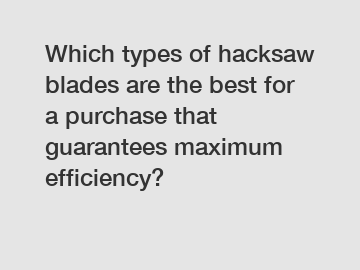Which types of hacksaw blades are the best for a purchase that guarantees maximum efficiency?
Which types of hacksaw blades are the best for a purchase that guarantees maximum efficiency? This is a common question asked by those who frequently use hacksaws for cutting various materials. In order to find the answer, it is important to consider the characteristics and quality of different hacksaw blades, as well as their specific applications.
When it comes to hacksaw blades, there are several types available in the market. One of the most common types is the carbon steel hacksaw blade. These blades are known for their durability and versatility, making them suitable for cutting a wide range of materials, including wood, plastic, and metal. They are also budget-friendly, making them a popular choice among many users.
Another type of hacksaw blade that is gaining popularity is the bi-metal hacksaw blade. As the name suggests, these blades are made from a combination of two different metals, typically high-speed steel and alloy steel. This combination results in a blade that combines the best attributes of both materials - the hardness and durability of high-speed steel, and the flexibility of alloy steel. Bi-metal blades are known for their long cutting life and ability to handle tough materials, such as hardened steel and stainless steel.

To determine the best hacksaw blade for maximum efficiency, it is important to consider the specific application. For cutting softer materials like wood and plastic, a carbon steel blade would be sufficient. However, when it comes to cutting harder materials, such as metals, a bi-metal blade would be a better choice due to its superior strength and durability.
In addition to the type of blade, it is also crucial to consider the number of teeth per inch (TPI) when purchasing a hacksaw blade. The TPI refers to the number of teeth on the blade per inch. Blades with a higher TPI are better suited for cutting thinner materials, as they provide a finer and smoother cut. On the other hand, blades with a lower TPI are more suitable for cutting thicker materials, as they provide a faster cutting speed.
The choice of hacksaw blade type and TPI can significantly impact the efficiency and performance of the cutting process. Using the wrong type of blade or TPI for a specific material can result in slower cutting speed, increased effort, and poor quality of the cut.
In conclusion, when it comes to purchasing hacksaw blades that guarantee maximum efficiency, it is essential to consider the type of blade and TPI. Carbon steel blades are versatile and budget-friendly, while bi-metal blades offer superior strength and durability. The choice depends on the specific application and the material being cut. Additionally, selecting the appropriate TPI can greatly enhance the cutting process. By understanding the characteristics and applications of different hacksaw blades, users can make an informed decision and achieve optimal efficiency in their cutting tasks.
If you are looking for more details, kindly visit wet core drill supplier, 350mm Laser Welding Diamond Blade, Tct Saw Blade for Wood.


